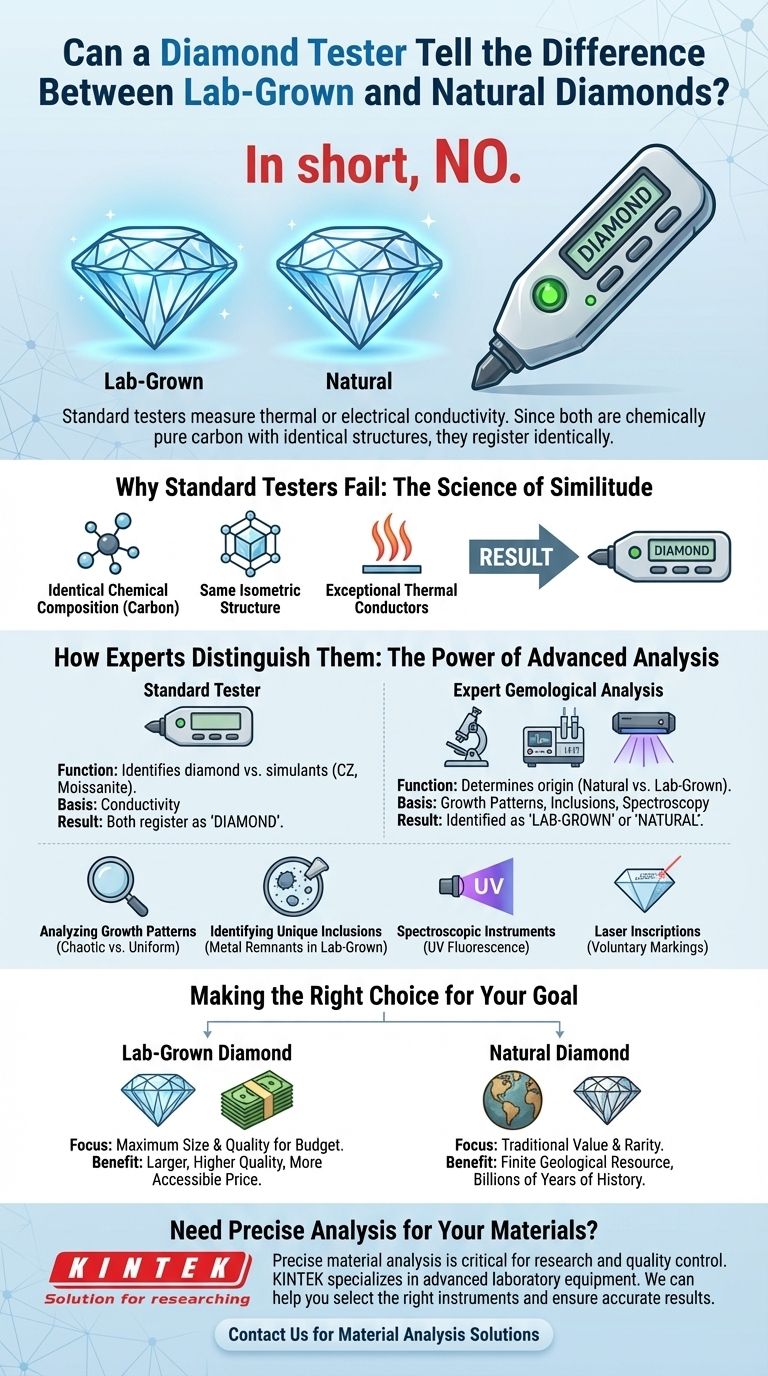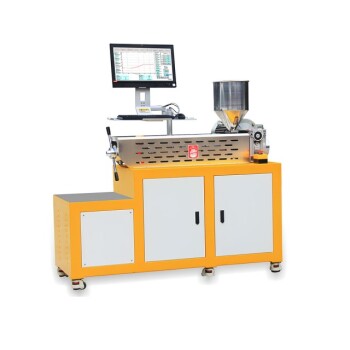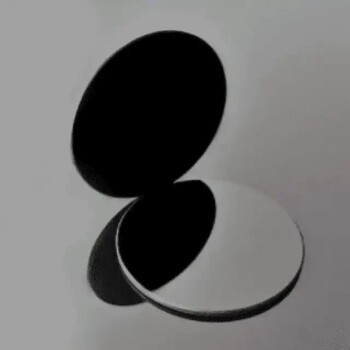In short, no. A standard, handheld diamond tester cannot tell the difference between a lab-grown diamond and a natural diamond. Because both are physically and chemically identical, these tools will correctly identify both stones as "diamond" without distinguishing their origin.
A standard diamond tester confirms a stone's identity by measuring its thermal or electrical conductivity. Since lab-grown and natural diamonds are both pure carbon with the same crystal structure, they register identically. True differentiation requires specialized gemological laboratory equipment.

Why Standard Testers See Them as the Same
A common misconception is that a lab-grown diamond is a "fake" diamond. This is incorrect. It is a real diamond, simply created in a different environment. This is the key to understanding why basic testers fail to distinguish them.
The Principle of a Diamond Tester
Most handheld diamond testers are designed to do one thing: separate diamonds from common simulants like cubic zirconia or moissanite. They work by touching the stone with a small metal tip that measures how quickly it conducts heat or, in some advanced testers, electricity.
Identical Physical Properties
Diamonds, both natural and lab-grown, are exceptionally good thermal conductors. They pull heat away from the tester's tip far more effectively than any simulant. Since a lab-grown diamond is chemically pure carbon crystallized in the same isometric structure as a natural one, its thermal and electrical properties are identical. The tester simply registers "diamond."
What Testers Can Detect
These tools are highly effective for their intended purpose: flagging fakes. A tester will easily show that cubic zirconia, glass, or white sapphire are not diamonds. However, its job ends there. It cannot provide information about the diamond's origin.
How Experts Actually Distinguish Them
While a simple tester is blind to a diamond's origin, a trained gemologist with advanced laboratory equipment can make a definitive identification. The differences are subtle and relate directly to their vastly different growth environments.
Analyzing Growth Patterns
Natural diamonds form over billions of years under chaotic conditions, resulting in specific growth patterns and graining. Lab-grown diamonds are created in a highly controlled process over weeks or months, which produces different, more uniform growth structures. These can only be seen with powerful magnification and specialized lighting.
Identifying Unique Inclusions
Inclusions are tiny imperfections within a diamond. In natural diamonds, these are often microscopic crystals of other minerals that were trapped during formation. Inclusions in lab-grown diamonds, however, may be tiny metallic remnants from the growth chamber—a clear indicator of a man-made origin.
The Role of Sophisticated Equipment
Gemological labs use advanced spectroscopic instruments to analyze how a diamond interacts with light, particularly in the ultraviolet spectrum. The specific way a diamond fluoresces or phosphoresces under deep UV light can reveal its atomic structure and conclusively determine if it grew in the earth or in a lab.
Deliberate Markings: Laser Inscriptions
To ensure full transparency, most reputable producers of lab-grown diamonds voluntarily use a micro-laser to inscribe the stone's girdle with a serial number and a phrase like "Lab Grown." This inscription is invisible to the naked eye but is easily seen under a jeweler's loupe.
Understanding the Trade-offs
The inability of a simple tester to differentiate between lab and natural diamonds highlights a crucial point: you are choosing between two versions of the same material, with the primary difference being origin and rarity.
The Question of Rarity vs. Technology
A natural diamond's value is heavily tied to its rarity as a finite, geological resource. A lab-grown diamond's value is based on the technology, energy, and expertise required to create it. Because they can be produced on demand, they do not have the same rarity-driven value.
The Factor of Price
The most significant practical difference for a buyer is price. For a given budget, a lab-grown diamond will be substantially larger and of higher quality (in terms of color and clarity) than its natural counterpart.
Making the Right Choice for Your Goal
Ultimately, the choice depends entirely on your personal priorities. Neither is inherently "better"—they are simply different products that cater to different goals.
- If your primary focus is maximum size and quality for your budget: A lab-grown diamond provides a visually stunning stone at a much more accessible price point.
- If your primary focus is traditional value and rarity: A natural diamond, with its billions of years of history and finite supply, is the classic choice.
- If your primary focus is absolute certainty of origin: Always rely on a grading report from a respected gemological laboratory (like GIA or IGI), which will definitively state whether the diamond is natural or lab-grown.
Understanding that both are real diamonds empowers you to choose based on what matters most to you, whether that is budget, origin, or the story behind the stone.
Summary Table:
| Aspect | Standard Diamond Tester | Expert Gemological Analysis |
|---|---|---|
| Primary Function | Identifies diamond vs. simulants (CZ, moissanite) | Determines origin (natural vs. lab-grown) |
| Basis of Detection | Thermal/electrical conductivity | Growth patterns, inclusions, spectroscopy |
| Result for Lab-Grown | Registers as "diamond" | Identified as "lab-grown" |
| Equipment Required | Handheld tester | Advanced laboratory instruments (microscope, spectrometer) |
Need Precise Analysis for Your Materials?
While a standard diamond tester can't distinguish origin, precise material analysis is critical for research and quality control. KINTEK specializes in providing advanced laboratory equipment and consumables to meet your exact needs.
We can help you:
- Select the right analytical instruments for your specific applications.
- Ensure accurate and reliable results with high-quality lab supplies.
- Enhance your laboratory's capabilities and efficiency.
Contact us today to discuss how our solutions can support your work. Our experts are ready to assist you in finding the perfect equipment for your laboratory challenges.
Get in touch with our specialists now!
Visual Guide

Related Products
- Filter Testing Machine FPV for Dispersion Properties of Polymers and Pigments
- Metallographic Specimen Mounting Machine for Laboratory Materials and Analysis
- CVD Diamond Cutting Tool Blanks for Precision Machining
- Automatic Laboratory Heat Press Machine
- Infrared Thermal Imaging Temperature Measurement Double-Sided Coated Germanium Ge Lens
People Also Ask
- What is the significance of compression set? Predict Material Failure and Ensure Long-Term Reliability
- How to tell if a lithium-ion battery is bad? Spot the critical signs of failure before it's too late.
- Is there a battery tester for lithium batteries? Unlock Accurate Health Diagnostics Beyond Voltage
- What is the water content of pyrolysis oil? A Key Factor in Bio-Oil Quality and Use
- What is a filter tester? A Guide to Measuring Filtration Efficiency & Performance














